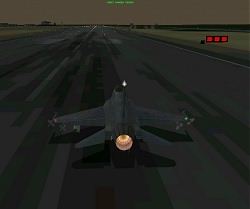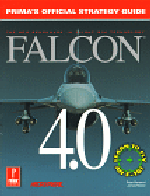| F4 Strategy Guide by Peter Bonnani and James Reiner |
||||
|
Reviewed by Leonard "Viking1" Hjalmarson This guide is publisher by PRIMA and is some 340 pages in length. It includes a large number of illustrations, but text dominates. Inevitably, there is substantial repetition of material from the Falcon 4 manual, but some sections contain more material that is better organized, and screen shots and diagrams are original to the Guide. Before we get into the nitty-gritty, here is a partial listing of chapters in the Guide:
The Guide seems to be designed in such a way that someone who does not have access to the original manual can use the Guide to get the most out of F4. It's an appealing layout, and I would guess that many who have never flown F4 will be attracted to the sim via this guide. The integration of "I was there" sections is attractive and sets the mood. It's interesting to note, however, that the space devoted to the Campaign and to Tactical Engagement is quite brief. Perhaps for the best, since TE especially is likely to change substantially over time.  But what's in it for those who already own the game? Comparing the sections on Realistic Radar, the Guide has twenty one pages to the seventeen in the F4 manual. However, the section in the Guide integrates the discussion of the B scope (section in the manual pages (4-6 to 4-9), so length alone doesn't show what is happening here. Let's take a look at a sub-section from each to compare the approach. The F4 manual, section 21 page 22, contains a sub section describing 30x20 Submode. This single paragraph is about thirty five words in length. There is more information to be found in the F4 manual if you search for it (section 4-4 4-5, and in the training mission, 4-12 to 4-13), but in the Guide most of this info is available in a single section, on page 154. Here it is: |
 HUD MODE (20 x 30) Use this radar search pattern when you can turn and point your jet close enough toward the target to see it in the HUD. The radar scan pattern in this mode searches a 20x30 degree area that closely resembles the field of view (FOV) through your HUD (Figure 10-18). The one limitation to using this mode occurs when you have several aircraft together within your HUD FOV. The first contact the radar sees as it scans this area will be the one it acquires, whether it was the one you wanted or not. TO be more discriminating about which aircraft you lock, refer to the next section on Boresight scan mode. If no other aircraft are near by the target, the HUD scan mode will certainly do the job. The HUD symbology with this scan pattern does not give you any specific cues about what scan mode the radar is using, so confirm you have selected the HUD scan mode by glancing down at your radar MFD. As in figure 10-19, you'll see ACM indicating your current air-to-air radar mode and "20," displayed on the top center of the MFD. In this ACM scan mode, the two vertical "goal post" lines set in the center of the MFD represent the 30 degree wide scan pattern. As the radar is sweeping to find a target, you'll see the elevation caret moving up and down the left side of the MFD and the azimuth caret cycling within the confines of the search pattern at the bottom. No target information is displayed because the radar has not locked on, because you are presumably looking through the HUD to acquire something. When the radar acquires a target, you'll see the digital readout of information on the contact across the top of the MFD, the radar picture will return to a B scope display, and the target will be displayed as an STT symbol. From this quotation, you may get the idea that Bonanni assumes a lesser degree of familiarity with the systems of the F16 than the writers of the manual assume. This, plus the greater integration of the Guide itself, explains the greater length of many sections. The Guide would make a good gift or companion volume for air combat simulation novices who want to get the most from Falcon 4. What about the rest of us? Good question! As I transitioned to the later chapters of the manual, notably eighteen and forward, I was looking for some additional tactical information. For example, I was curious to see if Bonanni would address the question of transitioning from a BVR engagement to a within visual range engagement, and the move from TWS radar mode to an ACM mode. Go to Part II
|
|||
|
© 1997 - 2000 COMBATSIM.COM, INC. All Rights Reserved. Last Updated February 16th, 1999 |
||||
